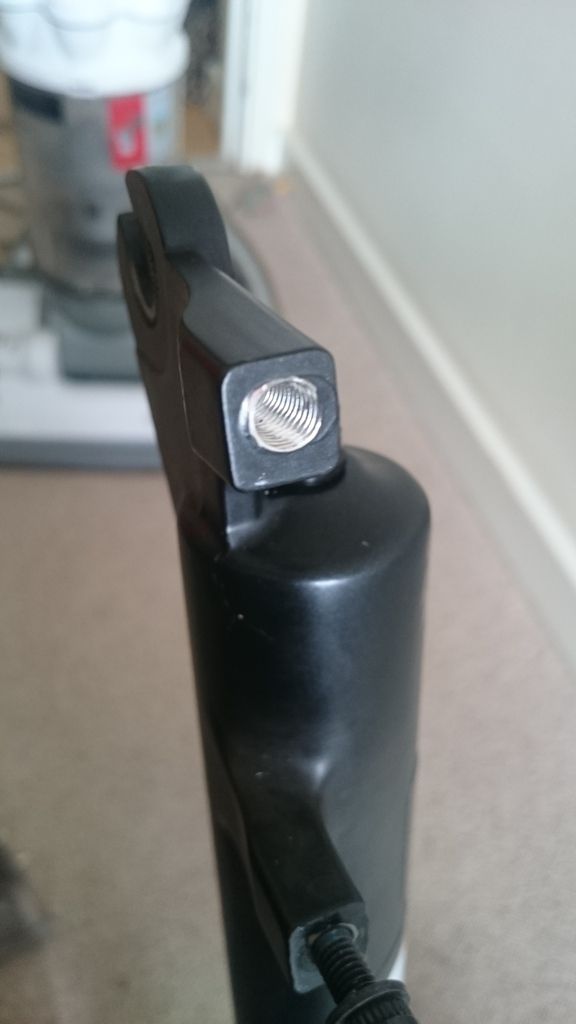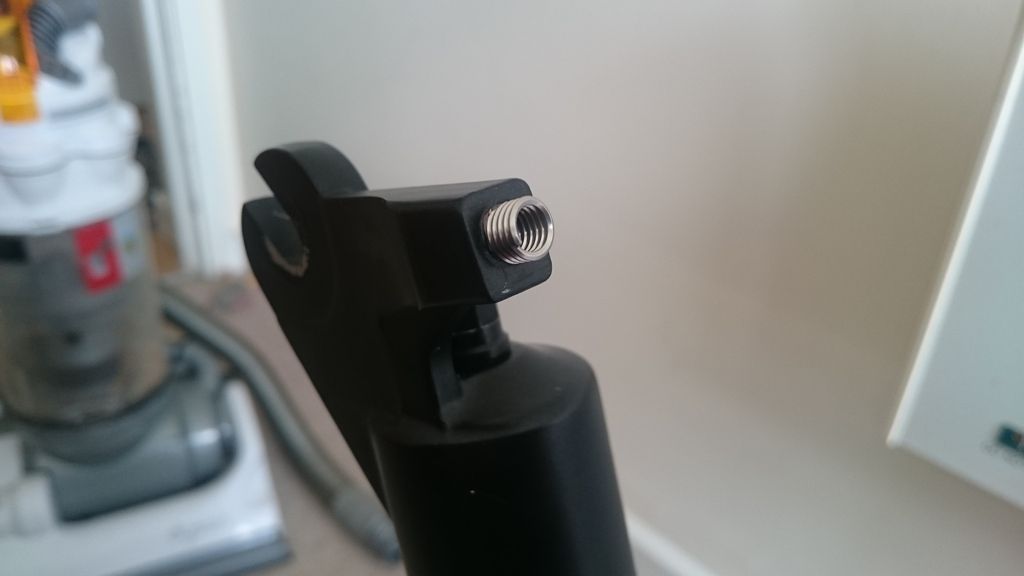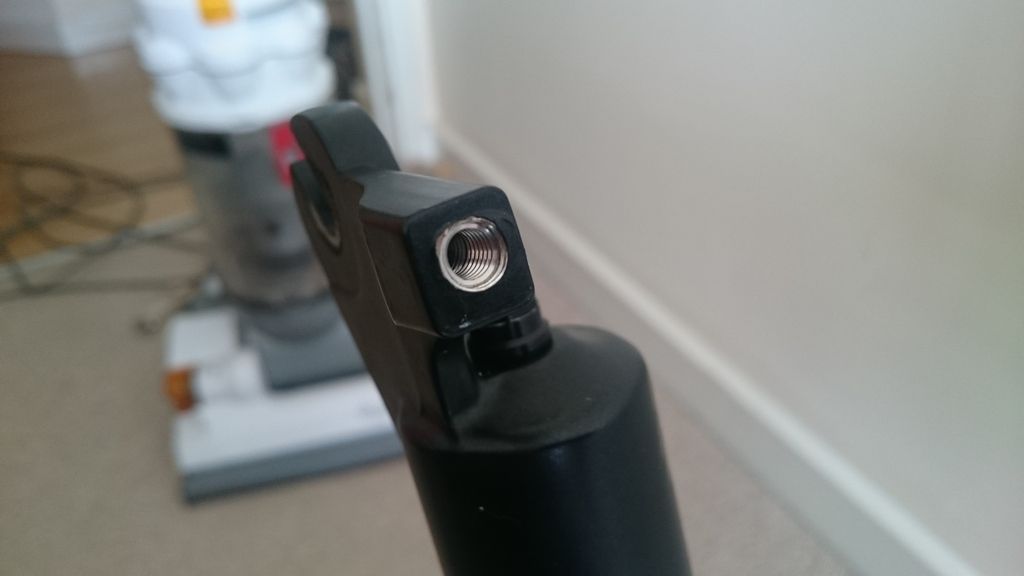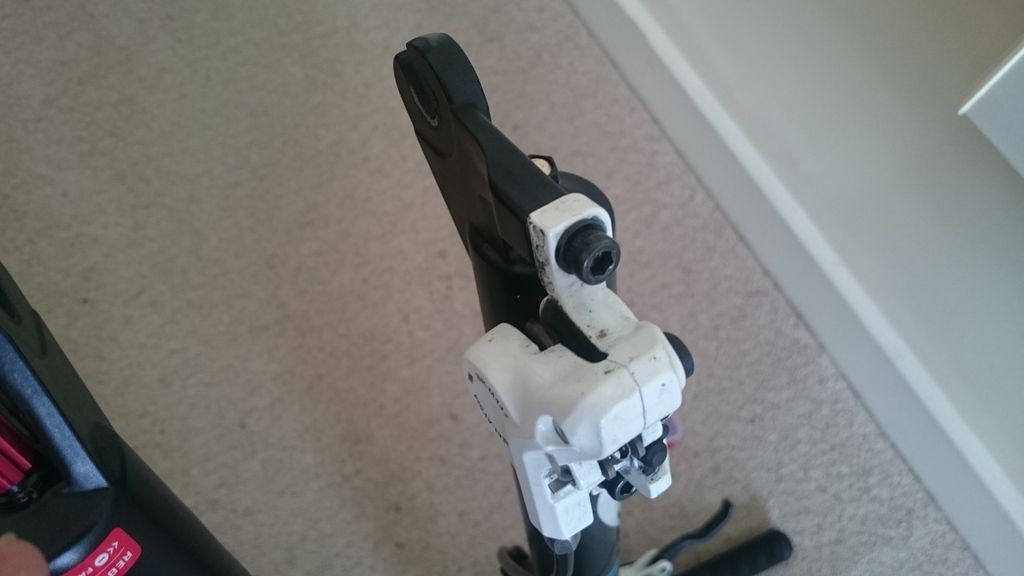Stripped a thread/bolt
Clockworkmark31
Posts: 1,053
Geetings all,
After realigning my front caliper as the tinging of the rotor was annoying me I felt the bolt slip as I was re tightening and immediate knew what had happened. Removed the bolt to see one thread had been removed (was attached to the bolt), inspected the bolt and couldn't see any damaged threads. So put a new bolt in with abit of blue threadlock and it tightened up nice, out of curiosity I put the suspect damaged bolt in to the other mounting again with a dab of threadlock and nervously tightened and it tightened fine.
So I know the bolt or thread on the lower forks stripped one thread but both suspect bolt and suspect thread on lowers tightened up fine.
Any cause for concern here?
After realigning my front caliper as the tinging of the rotor was annoying me I felt the bolt slip as I was re tightening and immediate knew what had happened. Removed the bolt to see one thread had been removed (was attached to the bolt), inspected the bolt and couldn't see any damaged threads. So put a new bolt in with abit of blue threadlock and it tightened up nice, out of curiosity I put the suspect damaged bolt in to the other mounting again with a dab of threadlock and nervously tightened and it tightened fine.
So I know the bolt or thread on the lower forks stripped one thread but both suspect bolt and suspect thread on lowers tightened up fine.
Any cause for concern here?
0
Comments
-
Yes it is a big cause for concern.
What do you think is now holding the caliper in place?"Do not follow where the path may lead, Go instead where there is no path, and Leave a Trail."
Parktools :?:SheldonBrown0 -
Yes it is a big cause for concern.
What do you think is now holding the caliper in place?
But the suspect thread on the forks tightened up fine alone with the suspect bolt in the opposite thread. They both torqued up fine.
Just to clear up it was either one thread on the bolt it's self or one thread inside the mounting post if that makes sense.0 -
with the amount of thread in them, and the minimal circa 8nm torque, i would say 1 missing thread is fine.
the location of the calipers tends to have them pushing into the mount while braking.
sounds like you may have started the 1 bolt a bit wonky, and its just pulled the first thread out. Aslong as its as you say, and they torqued up fine, just ride it!0 -
with the amount of thread in them, and the minimal circa 8nm torque, i would say 1 missing thread is fine.
the location of the calipers tends to have them pushing into the mount while braking.
sounds like you may have started the 1 bolt a bit wonky, and its just pulled the first thread out. Aslong as its as you say, and they torqued up fine, just ride it!
Thanks, the bolt went in straight it was only when I was nipping it up I felt it go. Never done this before so was shocked.
Think I may have missed the sarcastic earlier response haha if it was aimed at being sarcastic.0 -
I would take Nick's advice and check more carefully.I don't do smileys.
There is no secret ingredient - Kung Fu Panda
London Calling on Facebook
Parktools0 -
I would take Nick's advice and check more carefully.
Really for one thread, you would still have 90%+ threads for compression.
I am happy to reinspect, but when I looked at the bolt I didn't see any obvious damage. Once said bolt was unwound from the mounting post the stripped thread presented itself on the first thread of the bolt.
If I stripped a final thread on the fork mounting point how could I tell? And if I can tighten them to the correct torque forgive me if I sound dumb in asking this is there really a problem?0 -
Okay so I have now answered my questions to the above so thank you to cool dad and nick.
Upon using a loupe (that's all I have to hand at home) both bolt threads are intact.
But the lower caliper mounting point on the forks the first 50% of thread has stripped. Might explain the recent tinging in the rotor.
What options would be available without replacing the lowers? And I know it is late in the day for asking this, but is it still useable for the interim? I use it for getting to and from work and funds are slightly tight until payday.0 -
[url=http://www.bikeradar.com/forums/viewtopic.php?p=19631053#p19631053]Clockworkmark31[/url] wrote:Okay so I have now answered my questions to the above so thank you to cool dad and nick.
Upon using a loupe (that's all I have to hand at home) both bolt threads are intact.
But the lower caliper mounting point on the forks the first 50% of thread has stripped. Might explain the recent tinging in the rotor.
What options would be available without replacing the lowers? And I know it is late in the day for asking this, but is it still useable for the interim? I use it for getting to and from work and funds are slightly tight until payday.
Okay very unsure how this happened in the first place as it is all original parts and I haven't removed the caliper before now. Only removed it because I was sick of the tinging.
With it still being in warranty I don't want to tap and die it or use a helicoil etc as I am not 100% I will get it perfectly centered.
Could this be classed as a warranty claim? The bike was purchased through a large cycle to work scheme. But I am unsure who does the final assembly. So not sure if the manufacturer or supplier are my first port of contact.0 -
Welcome to the world of post mount. Give me 'old' IS anyday.
I doubt it would be a warranty claim as you appear to have done it yourself, but first your contract is with the seller, so that's where you have to go.
Helicoil may or may not be possible, depends on the thickness of the metal in the mounts.I don't do smileys.
There is no secret ingredient - Kung Fu Panda
London Calling on Facebook
Parktools0 -
You should be able to use a helicoil.
Do some reading: https://www.google.co.uk/search?q=helicoil+fork+post+mount0 -
PM would be ok if you could slot a replaceable nut into the post. But as they don't seem to do that it's turd.0
-
Having seen IS lugs snapped, not sure PM is worse at all.
The lower is the pain asit's the omne in tension, if you can't get it helicoiled then I'd do the following.
get a longer bolt from a hardware store, the longest that will fit, use a tough threadlock, put the bolt in and NIP it up until the threadlock sets making some extra thread and reinforcing any slightly damaged ones, then do it up. Saved a few threads like that over the years.Currently riding a Whyte T130C, X0 drivetrain, Magura Trail brakes converted to mixed wheel size (homebuilt wheels) with 140mm Fox 34 Rhythm and RP23 suspension. 12.2Kg.0 -
[url=http://www.bikeradar.com/forums/viewtopic.php?p=19631049#p19631049]Clockworkmark31[/url] wrote:...the bolt went in straight it was only when I was nipping it up I felt it go...
...Really for one thread, you would still have 90%+ threads for compression.
... when I looked at the bolt I didn't see any obvious damage. Once said bolt was unwound from the mounting post the stripped thread presented itself on the first thread of the bolt.
... if I can tighten them to the correct torque forgive me if I sound dumb in asking this is there really a problem?
Sorry, I can't let this go:
The threads in the fork leg are fucked.
Every thread for the depth of the bolt has been stripped, not just one.
The bolt won't be damaged as it is high tensile steel (~500+ MPa yield strength) vs the cast aluminium leg (~150 MPa yield strenth if you're lucky).
You only found one thread on the bolt because it's the one that has been wound out of the leg when you over tightened it. The rest are still in the hole, wedged in, or loosely attached.
The torque setting is the start point for the strength of the connection - it puts a certain amount of tension in the bolt to hold the assembly together. When you put the brakes on, they will be putting even more tension on that bolt. The threads need to be strong enough to withstand this in addition to the tenion from torquing the bolt up. If the bolt is only just holding the tightening torque, it will pull out if/when you hit the brakes hard.
You *might* be able to bodge it by getting a longer bolt, but it will need to be longer by at least the diameter of the bolt, and it will quite possibly end up being cross threaded where the stripped threads meet the original ones at some random place.
This is your front brake FFS.
Get it helicoiled, or bin the forks - and don't even think about a warranty claim!0 -
Thanks for the replies. Was thinking of tapping it to an m7. But think helicoil is going to be the most reliable and strongest option.
Just ordered a m6 helicoil kit. Anything I should look out for. I have used them before but not on something so fragile.0 -
[url=http://www.bikeradar.com/forums/viewtopic.php?p=19631049#p19631049]Clockworkmark31[/url] wrote:...the bolt went in straight it was only when I was nipping it up I felt it go...
...Really for one thread, you would still have 90%+ threads for compression.
... when I looked at the bolt I didn't see any obvious damage. Once said bolt was unwound from the mounting post the stripped thread presented itself on the first thread of the bolt.
... if I can tighten them to the correct torque forgive me if I sound dumb in asking this is there really a problem?
Sorry, I can't let this go:
The threads in the fork leg are farked.
Every thread for the depth of the bolt has been stripped, not just one.
The bolt won't be damaged as it is high tensile steel (~500+ MPa yield strength) vs the cast aluminium leg (~150 MPa yield strenth if you're lucky).
You only found one thread on the bolt because it's the one that has been wound out of the leg when you over tightened it. The rest are still in the hole, wedged in, or loosely attached.
The torque setting is the start point for the strength of the connection - it puts a certain amount of tension in the bolt to hold the assembly together. When you put the brakes on, they will be putting even more tension on that bolt. The threads need to be strong enough to withstand this in addition to the tenion from torquing the bolt up. If the bolt is only just holding the tightening torque, it will pull out if/when you hit the brakes hard.
You *might* be able to bodge it by getting a longer bolt, but it will need to be longer by at least the diameter of the bolt, and it will quite possibly end up being cross threaded where the stripped threads meet the original ones at some random place.
This is your front brake FFS.
Get it helicoiled, or bin the forks - and don't even think about a warranty claim!
Have taken your good advice on-board. But if you read my earlier response I reinspected and found more threads to be damaged also how could I have over tightened it using a torque wrench.0 -
A torque wrench is only as good as the calibration, and user.I don't do smileys.
There is no secret ingredient - Kung Fu Panda
London Calling on Facebook
Parktools0 -
[url=http://www.bikeradar.com/forums/viewtopic.php?p=19631875#p19631875]Clockworkmark31[/url] wrote:But if you read my earlier response I reinspected and found more threads to be damaged also how could I have over tightened it using a torque wrench.
Very very easily.
An unsuitable torque wrench. A poor calibrated torque wrench. A user that does not how to use a torque wrench.
Torque wrenches often cause more issues than they solve.
Not to mention the fork makers going to a poor, but lightweight, caliper mounting system."Do not follow where the path may lead, Go instead where there is no path, and Leave a Trail."
Parktools :?:SheldonBrown0 -
[url=http://www.bikeradar.com/forums/viewtopic.php?p=19631875#p19631875]Clockworkmark31[/url] wrote:...if you read my earlier response I reinspected and found more threads to be damaged also how could I have over tightened it using a torque wrench.
I did read all your responses, and came to the conclusion that you didn't know what you were doing. Hence my post.
I must have missed the bit where you said you were using a torque wrench. I'd get it checked.0 -
[url=http://www.bikeradar.com/forums/viewtopic.php?p=19631875#p19631875]Clockworkmark31[/url] wrote:...if you read my earlier response I reinspected and found more threads to be damaged also how could I have over tightened it using a torque wrench.
I did read all your responses, and came to the conclusion that you didn't know what you were doing. Hence my post.
I must have missed the bit where you said you were using a torque wrench. I'd get it checked.
Well I did mention that both bolts torqued up fine after reinserting them, I guess this could have been mistaken for the inbuilt torque gauge in my wrist. But thank you for presuming I am incompetent.
Yes I know how to use and set a torque wrench too, now if it needs calibrating I will have to check.
But anyway just waiting for the kit to turn up and will helicoil the posts, thinking it might be a good idea to do both of them? Annoying as the rear caliper is IS mount.
Oh well, will put some pictures up before and after once it turns up, will make sure I have my uncalibrated ruler and verniers in the photos just to annoy people even more.
Joking I get the importance of calibration, I have to get all my electronic test equipment done every three months annoying but fundamental.0 -
Well in true fashion the helicoil kit turned up today and my trusty makita refuses to work (damn brushes). Might take it in to work and use the pillar drill. Don't think I could hand drill it in.
Best to do both post mounts or just the affected one?
Also one or two helicoils per mount?0 -
Pillar
Needed
One0 -
Thanks chunkers.
Will get the forks into work and use the pillar. Was tempted by some cheap Ebay ones but got a recoil one from local HW shop looks good quality.
Shame it probably be used once.0 -
Another quick one forgot to add it above, insert the helicoil all the way home or partially. I'm assuming partially but just want to check.0
-
As promised, easy 10 minute job to do.

Old Thread drilled
New thread tapped
Start of the helicoil going in
Helicoil home with tang broke off
Job done
Kit I used
Well, it really was easy. Would mention to anyone doing it clean after every step to remove metal filings (after drilling out, after tapping etc) and use cutting lubricants. The tap went in like a warm knife through butter.0 -
Also don't tell but I rolled the dice and thought I can't make it any worse (brushes for my drill didn't turn up in time) couldn't be bothered taking it in to work to use a pillar drill.
So one of these did the job http://www.albrecht-germany.com/en/information/medical-technology/selftightening-drill-with-stainless-steel-reversing-lock-and-thread-mount-unf.html#.VZhaEflTPcc at all times I felt in control.0

